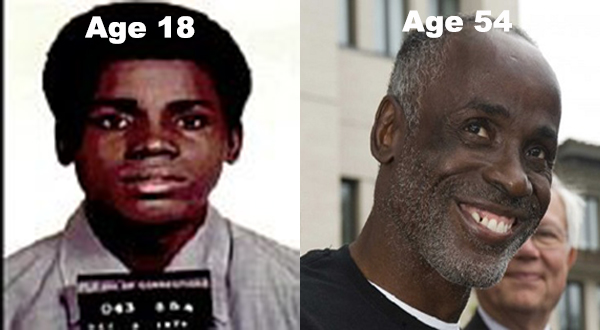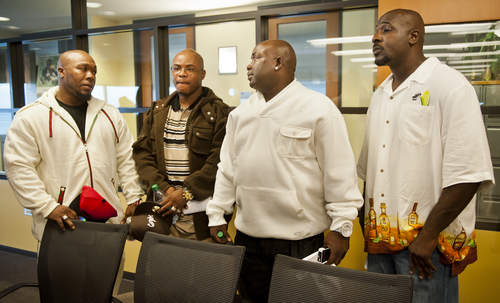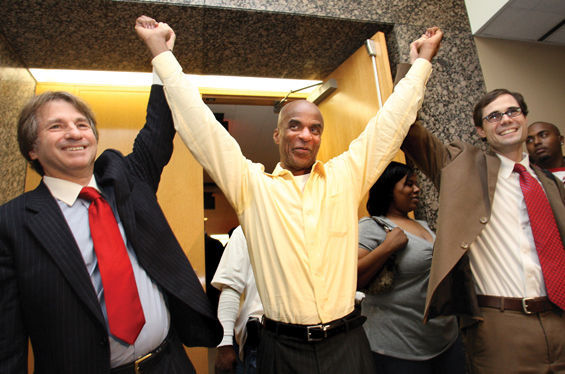10 Black Men Recently Freed After Decades of False Imprisonment

Charles Chatman
In 1981, after a Dallas woman was reportedly raped in her house, she picked 20-year-old Charles Chatman, who lived down the street from her, out of a lineup.
Soon thereafter, Chatman was charged and convicted of rape and was sentenced to 99 years in prison. He maintained he was an innocent man and said the victim misidentified him as the culprit. He went to the parole board three times but according to sources, was denied every time because he refused to admit guilt to the crime.
However, after years of struggling to get a DNA test, the court finally allowed him to do it in 2007. In 2008, the DNA exculpated him in the rape. Chatman was officially exonerated on February 26, 2008, after spending 27-years in prison.
As of 2012, Chatman had received $2,417,845 in state compensation.

James Bain
In 1974, at the young age of 18, James Bain was arrested and later convicted of breaking and entering, kidnapping, and raping a nine-year-old boy. He was sentenced to life in prison.
The victim told police that his assailant appeared to have been 17 or 18 years old, had a mustache and bushy sideburns and his name was “Jim” or “Jimmy.” The victim’s uncle, who was an assistant principle, thought the description sounded a lot like a student at his school, “Jimmy Bain.” The boy picked Bain out of a photo lineup that included one other man with bushy sideburns. There were lingering questions about whether detectives steered him.
A jury convicted Bain after rejecting his story that he was home watching TV with his twin sister when the crime was committed, an alibi she repeated at a news conference right before his release.
After spending 35 years in prison, the court agreed to do DNA testing, which proved that Bain couldn’t have committed the rape. The state vacated his sentenced and at 54 years old, he found himself a free man.
Bain spent more time in prison for a crime he did not commit than any other American exonerated through DNA evidence. Until his conviction, he’d never had more than a few parking tickets.
The state of Florida awarded Bain a paltry $50,000 for each year he was incarcerated, which totaled $1.75 million.

Kash Delano Register
Kash Delano Register was only 19 years old when he was arrested and sentenced to 27 years to life in prison for killing 78-year-old Jack Sasson in April of 1979, but he has always maintained his innocence.
During his trial that same year, key witness Brenda Anderson testified that Register, whom she had gone to high school with, shot her elderly neighbor to death. Thirty-four years later, Anderson’s sister Sharon took the stand and said the account, which helped send the young man to prison, was a lie.
Earlier this month, a Los Angeles County Superior Court judge sided with Sharon Anderson and threw out the conviction of Register, who maintained his innocence during more than three decades as inmate No. C11693, according to the Los Angeles Times.
Register took his first steps of freedom on Friday November 8, 2013. The 53-year-old exonerated inmate was transported from a Northern California jail to the Twin Towers Correctional Facility in downtown Los Angeles, where he left a free man, CBS Los Angeles reported.
“It was just an emotional feeling that just came out of nowhere,” Register said. “Finally, after 34 years.”
Kash Register has not yet announced whether he’ll seek compensation for his false conviction and imprisonment, although it is likely.
source: atlantablackstar.com

Alan Newton
Alan Newton was between 26 and 27 years old when he was convicted in 1985 of rape, robbery and assault in the Bronx, New York, largely on the basis of testimony from the victim and an eye witnesses. Newton maintained that he was innocent and said that he had been mistakenly identified. He was eventually sentenced to up to 40 years in prison and spent the next 22 years behind bars away from his daughter and fiance.
At about 4:00 AM on June 23, 1984, the 25-year-old victim stopped at a convenience store in the Bronx, New York. As the victim was leaving the store, she was grabbed from behind by another customer, who put a box cutter to her throat. The assailant raped her in a park and in an abandoned building, then cut her face leaving her blind in one eye. While still recovering in the hospital, she identified Newton out of almost 200 photos.
Newton had asked for a DNA test in 1994, but his request was denied because evidence had been presumed to be lost. After another 11 years of searching, the rape kit was found and post conviction DNA testing then proved that Newton was not the perpetrator of this crime. Newton was released in 2006.
A jury awarded him $18.5 million in compensation, but Judge Shira Scheindlin took it away arguing that Newton didn’t deserve the money because the city had not intentionally violated his civil rights.

Anthony Graves
In 2010, Anthony Graves was released after spending 18 years in prison away from his family. Graves was 26-years old when he was convicted in 1994 of assisting Robert Carter in the murder of six members of a Texas family in 1992. There was no physical evidence linking Graves to the crime, and his conviction relied primarily on Carter’s testimony.
Two weeks before Carter was scheduled to be executed in 2000, he provided a st
atement saying he lied about Graves’ involvement in the crime. He repeated that statement minutes before his execution.
In light of Carter’s new statement, in 2006 the U.S. Court of Appeals for the Fifth Circuit overturned Graves’ conviction and ordered a new trial after finding that prosecutors elicited false statements and withheld testimony that could have influenced the jurors.
The Harris County assistant district attorney office still wanted to retry Graves but soon realized that the only evidence they had was Carter’s statement and making a new case against Graves would be impossible:
“After months of investigation and talking to every witness who’s ever been involved in this case, and people who’ve never been talked to before, after looking under every rock we could find, we found not one piece of credible evidence that links Anthony Graves to the commission of this capital murder. This is not a case where the evidence went south with time or witnesses passed away or we just couldn’t make the case anymore. He is an innocent man,” a statement from the D.A. office read.
Anthony Graves was paid $1.45 million in compensation.
source: deathpenaltyinfo.org
 Clarence Harrison
Clarence HarrisonClarence Harrison was 28 years old when he was picked up by police in Decatur, GA as a suspect in a kidnapping, rape, and robbery. No hard evidence connected him to the case, but he lived close to where the victim was abducted, and police had received a tip indicating his involvement in the crime.
The victim’s eyewitness identification sealed Clarence’s fate and on March 18, 1987, he was convicted and sentenced to life plus twenty years in prison.
Harrison was told in the early 1990s that all the evidence had been destroyed and that the lab was unable to perform DNA analysis on the slides, but Harrison continued to pursue the test. Eventually they found the evidence and in February 2003, new DNA samples were taken from Harrison, and they were sent to a forensic lab in California, along with the slide from the rape kit. The lab returned the results in late August 2004 with the conclusion that the DNA evidence obtained from Harrison could not possibly belong to the same man whose DNA was in the rape kit.
On August 31, 2004, Clarence Harrison was released from prison after serving 18 years. At the age of 46, he had virtually disappeared from the lives of his two young daughters, who were 7 and 9 when he was incarcerated. He also could not attend the funeral of his mother, who never saw her son exonerated.
The Georgia General Assembly compensated Harrison with $1 million sum payable as an annuity over twenty years.
source: lifesentencealbum.com

Robert Clark
Robert Clark was 21 years old when he was convicted for rape, kidnapping, and armed robbery in Atlanta in 1981. He was sentenced to life in prison. At trial, Clark maintained that he was misidentified. With no previous criminal record, the former roofer was the only suspect to appear in both the photo array and the live line-up.
A defense witness testified that she saw another man, Tony Arnold, driving a car matching the victim’s Maroon Cutlass a few days after the rape. Arnold, who was in jail on an unrelated burglary charge, was brought to court and identified by the witness. Nevertheless, Clark was convicted although Arnold more closely resembled the victim’s description of the perpetrator.
Clark maintained his innocence and tried to obtain post-conviction DNA testing in the late 1990s but his request was denied. In July 2005, he finally got his wish and DNA testing proved that Robert could not be the perpetrator; the DNA proved Arnold, who was already in prison serving time for sodomy and cruelty to children, was the real perpetrator.
Peter Neufeld, Co-Director of the Innocence Project said, “The lead detective was so focused on him, that all other suspects, other incidents, or any discordant data failed to register. Tunnel vision not only cost Robert a quarter century of freedom, it enabled a serial rapist to assault at least three more victims.”
Clark, who was 45 when he left prison, was ecstatic to see his siblings, children and five grandchildren.
For his false imprisonment, Georgia compensated Robert Clark with $1.2 million.
source: nytimes.com

Dixmoor Five
The “Dixmoor Five” are five Chicago suburban kids who were wrongfully convicted of murder and rape while they were teenagers. The youngest being 14. Robert Taylor, Jonathan Barr, James Harden, Shainne Sharp and Robert Veal served more than 70 years between them for the 1991 rape and murder of 14-year-old Cateresa Matthews.
The five say the Dixmoor Police and the State Police coerced false confessions, withheld evidence and invented witness testimony. Taylor, Barr, and Harden were sentenced to 80 years each in prison, where they spent the next 19 years of their lives before being released in November 2011.
Sharp and Veal reportedly were intimidated by the police and lied on the other three defendants to get a lesser charge for a crime they didn’t commit. The two did 10 years in prison and were released prior.
Taylor, Barr, and Harden maintained their innocence and DNA evidence eventually exonerated them and identified the true killer, a convicted sex offender with no connection to them.
“We went through a lot,” an emotional Robert Taylor said. “This one incident destroyed so many lives.”
Harden says he has no family because his parents died while he was in prison. They never saw him exonerated.
The “Dixmoor Five” filed a federal lawsuit in 2012 against Dixmoor Police and Illinois State Police for unspecified damages.
source: suntimes.com

Thomas McGowan
In 1985, Thomas McGowan, from Dallas Texas, was sentenced to two consecutive life sentences at the age of 24 for burglary and aggravated sexual assault.
Around noon on May 7, 1985, a woman returned to her Richardson, Texas, home to find her television on the floor and pry marks on the door. Seconds later, as she told police, she was assaulted by an African-American man who beat and threatened her with a knife before raping her.
McGowan served 23 years in a Texas prison for a rape conviction that rested in part on an eyewitness identification in a faulty lineup. His photo was in the system only because of a minor traffic violation, but the victim identified him in a photo array after being coached by an officer.
The victim said she “thought” he was the perpetrator, but the police officer administering the lineup told her: “You have to be sure, yes or no.” After the officer’s instructions, the victim said McGowan was “definitely” the man who attacked her.
DNA test results showed that the sperm cells collected from the victim’s body during her hospital examination could not have come from Thomas McGowan. He was released from prison on April 16, 2008.
Thomas McGowan’s false imprisonment culminated in a $1.8 million compensation package from the state of Texas.
source: law.umich.edu


Andre Davis
In 1983, at the age of 19, Andre Davis from Chicago, was sentenced to 80 years for the murder and rape of a 3-year-old girl, a crime he swore he didn’t commit.
The murder occurred in the early evening of Aug. 8, 1980, in Rantoul, about 20 miles north of Champaign where Davis had been staying with his father for the summer. The young girl went outside to play before disappearing within minutes – prompting her mother and father to conduct a frantic search.
The child’s body was discovered next door where Lutellis “Sonny” Tucker and his brother, Maurice Tucker, lived, in Maurice Tucker’s bedroom. Davis had visited the house earlier in the day.
Davis was arrested after a friend of the Tuckers, Donald Douroux, told police that Davis had told him he had killed “a white woman” at the residence. Douroux said he went to the Tucker residence to check, bumped into the victim’s parents, searched the Tucker’s house with them, and discovered the victim’s body after the parents went back outside. He told authorities Davis committed the crime and led the authorities to his own home where Davis was visiting.
After two trials, where Douroux and the Tuckers testified against him, Davis was subsequently convicted of rape and murder and sentenced to 80 years in prison.
At age 50, DNA evidence concluded that Davis was innocent and helped overturn his conviction. In March 2012, an appellate judge ordered a new trial for Davis. Champaign County prosecutors, weighing the new evidence against their 32-year-old case file, dismissed the charges on Friday, July 6, 2012. A judge ordered Davis released immediately.
“There was no possibility in their mind that I didn’t do it,” Davis said upon being released.“ While I am happy to be free with my innocence established by the courts, I feel that those who are responsible for robbing me of the best years of my life should be held legally responsible for doing me so terribly wrong,” said Davis.
Andre Davis filed a wrongful conviction lawsuit at the U.S. District Court. The lawsuit is still pending. The DNA samples matched Maurice Tucker’s genetic profile, but prosecutors claimed the DNA evidence alone was not enough to charge him.
source: chicagoreader.com

Comments
Post a Comment